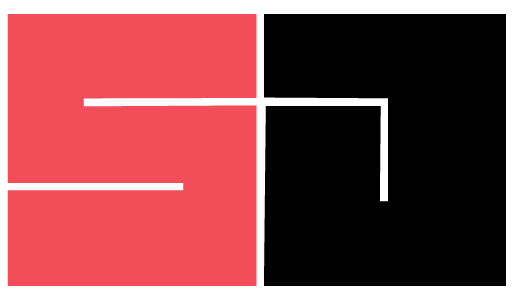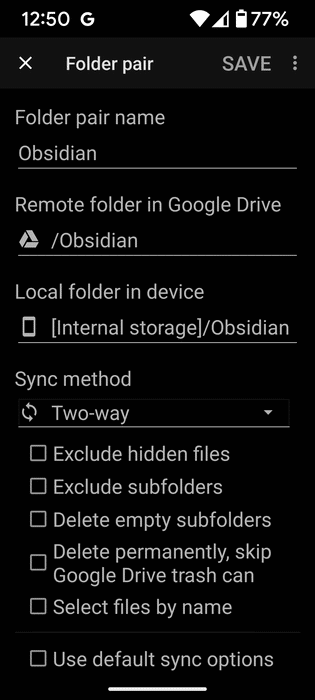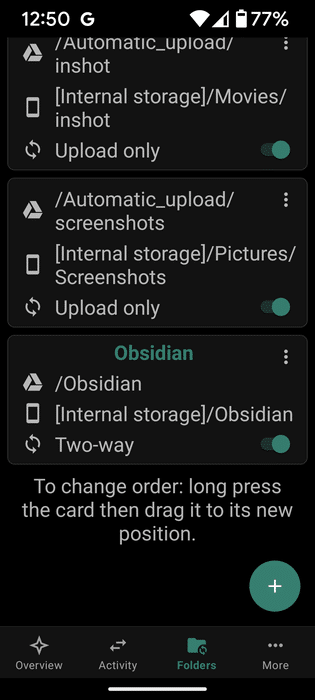As I mentioned in my year end review, one of the landmark habits I picked up in 2023 was using a Personal Knowledge Management (PKM) system on a regular basis. Specifically Obsidian. I’ve been using Obsidian for the last 6 months now, and it’s become such an integral part of my workflow that it’s the first app I open when I boot up my computer. And when I didn’t have access it to it for a month when my PC stopped working, I felt that I’d lost a part of my brain. In this post, I’ll explain how you can quickly get up to speed, and also show you best practices and little hacks to make your experience that much better.
Click on the links below to jump ahead to the section you’re interested in.
Table of Contents
Why you need a PKM?
Note taking and journaling are great for getting ideas out of your head and onto the page. I find that sometimes when I’m anxious, it’s because there’s a lot going on and just the act of committing my thoughts to a physical form makes me feel better. It’s easier to reason about your thoughts when they’re externalized. And notes are easy to edit, re-arrange and problem solve with.
The trouble with simple note taking is that notes tend to be transient, essentially acting as a scratch pad and are disposable. They provide immediate relief but aren’t made for posterity, are designed not to be revisited. When you maintain notes that are designed to be re-read, for the future, and are living documents, your knowledge base works for you.
I may spend hours or days researching a topic. When I don’t want that knowledge to go to waste, I’ll write a page in Obsidian for my future self. One of the great things about text, is it’s efficiently indexed and searchable. For instance, I attended a workshop a few months ago about hosting rental properties on Airbnb. It’s not something I’m working on right now, nor will I be in the foreseeable future. But I know I’ll have access to this information in a flash if I ever need it.
You also need a system to manage all the things going on in your life. At any given moment, I’m running between 2-5 projects and I need a way to track my progress, archive how-tos for later. There’s just no way to do this without some type of project management system. I like Obsidian because it doesn’t enforce any sort of paradigm or organization on you, and it’s easy to customize to your liking, for your specific application.
Ali Abdaal talks about using these “Second Brain” systems as helping with writer’s block and not having to start from a blank page. For content creators, PKMs provide valuable source material to mine new content from. Some of this blog post was put together using observations I’ve taken as I’ve been using Obsidian. I’ve yet to really leverage it this way but I can see the potential.
Why use Obsidian?
It’s free. It’s based on plaintext files written in Markdown so you’re not locked in to the platform. All your files are stored locally so you own them. There are loads of plugins to extend the functionality. It has fully functional apps on all major platforms and your files can be synced across them if you so choose.
I was already writing my notes in Markdown prior to using Obsidian so it felt like the choice that involved the least amount of change to my workflow.
Basics
Links
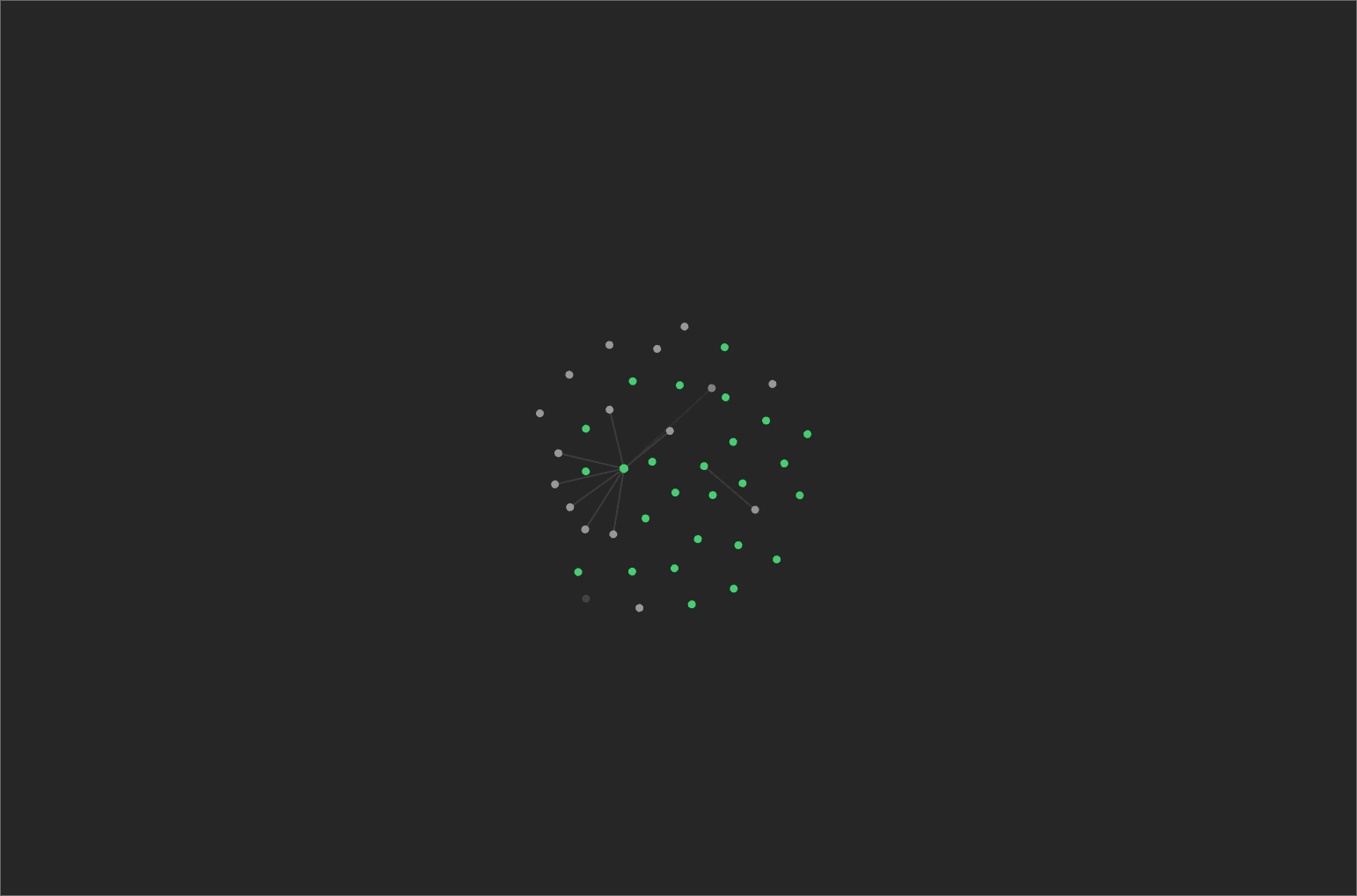
If you’re already used to taking notes, the killer feature that Obsidian offers is the ability to link notes together, creating a web of related pages like your own personal Wikipedia. Backlinks are created when you mention another note within a note. Here are a few useful recipes
- Create two notes and link them together using the
[[double bracket syntax]] - Create links to notes that don’t exist yet, for when you want to dive into a topic at a later time.
- Navigate between notes. The backlinks pane on the right sidebar is useful to view all pages that link to the current note
- Change the link display text instead of the note name to add more context
Tags and Folders
Tags are keywords or topics that help you quickly find the notes you want. To create a tag, enter a hash symbol (#) in the editor, followed by a keyword eg. #branding.
To find all notes with a certain tag, you can click the tag on a note, or by using the Search plugin. Use the tag search operator in your search term, for example tag:#meeting.
View all your tags using the Tags View in the right sidebar. Nested tags are another nice feature.
You can also create folders to group related notes together. That said, tags allow for a single note to be connected to multiple topics and offer a more natural way to organize the vault. There are some people who swear by tags, others who swear by folders. I’ve found that tags work well for me, I don’t use folders and haven’t missed them. If you really need the structure that comes with folders, consider using MOCs instead.
Properties
Properties allow you to add useful metadata to a note. You can search for notes containing properties using this syntax. Using the Dataview plugin explained in a later section, you can perform powerful operations around structured data in your vault.
Evergreen Notes
To get the most out of Obsidian, it helps to write notes that go beyond providing immediate relief. “Evergreen notes are written and organized to evolve, contribute, and accumulate over time, across projects.” Here are some best practices when taking notes:
- Atomic- notes should be about exactly one thing. Try not to make large monolithic notes, create new ones instead and link them to each other
- Densely linked- Try to think of the value of your knowledge base as being directly tied to how trafficked the pages are. The more you traverse your knowledge base, and the more often each page gets visited, the more valuable it is. They are no longer sad, orphan pages that never get looked at after they’ve been written. It forces you to read old pages and keep the information updated.
- Avoid hierarchies and instead use ontologies (webs)- Ideas often don’t fit in just one box or the other, they fit in both. Instead of imposing structure, you allow it to emerge organically. You do this by removing folders and instead using tags and links and infer connections post-hoc
- Write notes for yourself instead of an audience- unless you’re using it for work, no one else is going to see your notes. Feel free to use shorthand, and in way that you find quick to write and is easy to understand.
I highly recommend clicking through Andy Matuschak’s guide to taking evergreen notes. It has some great inspiration for how to get the most out of a PKM and make your knowledge work for you in the long run. Of all his suggestions, I think the idea of using ontologies and keeping pages densely linked is the one that make the most sense to me.
That said, I feel he takes some of his ideas too far, I’d spend way too much time to create a vault as pretty as his. For instance my notes aren’t nearly as atomic but they work for me. In any case, it’s a great jumping off point and I still recommend that you check it out and figure out what works for you.
Organization/Structure
Below are some note types I use, that might give you some ideas on how to structure your own vault.
Inbox
I create an Inbox note as a home for any shower thoughts, phone numbers, transient notes and the like. Sometimes I’m just pressed for time and I can’t always be bothered to organize my ideas into notes, or I’m on my phone so the Inbox file is pretty useful in such cases . I periodically clean out this file, extracting notes out of the information or just deleting them if they’re no longer useful.
This would be part of the “Capture ” habit in David Allen’s Getting Things Done system. You can read more about it at Robert Talbert’s GTD for Academics page. It’s a great series that I revisit from time to time.
Daily notes
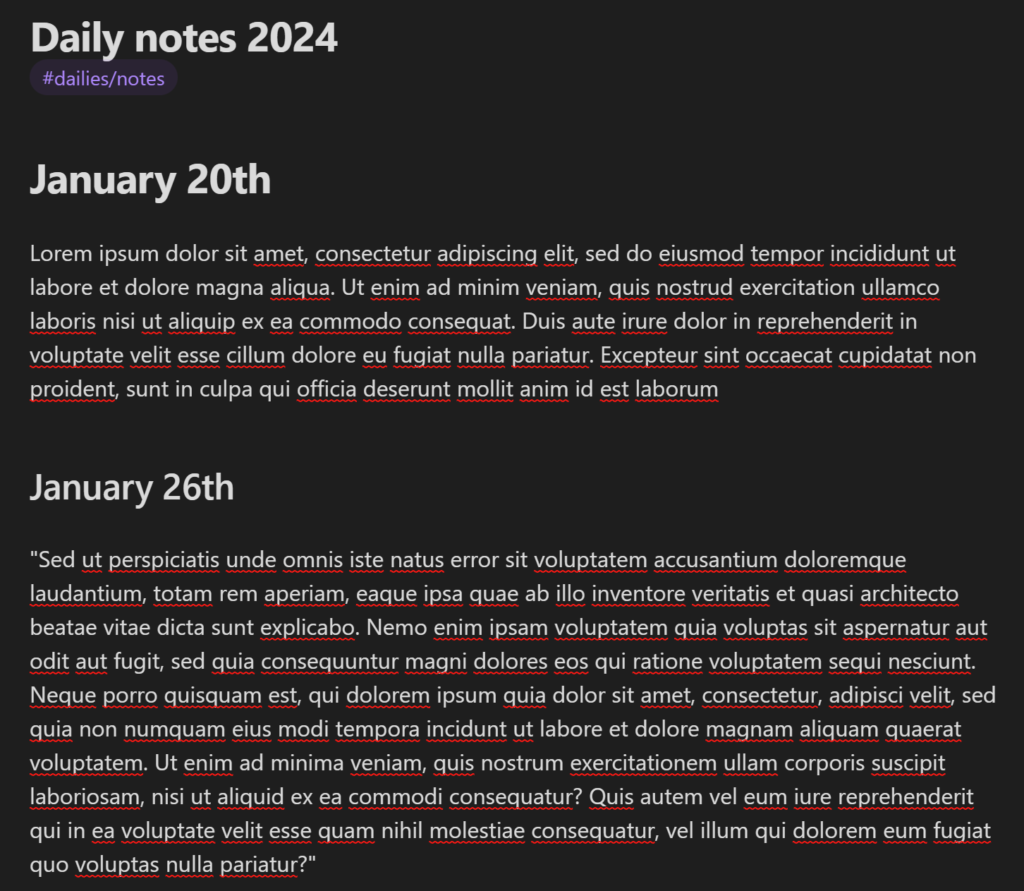
Daily notes tend to be journal entries or notes not tied to any projects. I create one note for each year and create subheadings for each day. This repository extends far back to 2015, before I had any real system for managing notes. I just continue to maintain them the way I used to. And to be clear, I don’t necessarily create a note everyday, it’s just that there’s a home for it if I do.
If you insist on keeping your notes truly atomic, you can instead use the “Daily notes” core plugin. A nice benefit of this is that you’ll get to view your notes overlaid on a calendar. I don’t do it this way as I don’t like to litter my vault with a million journal entries.
Maps of Content and Project Homepages
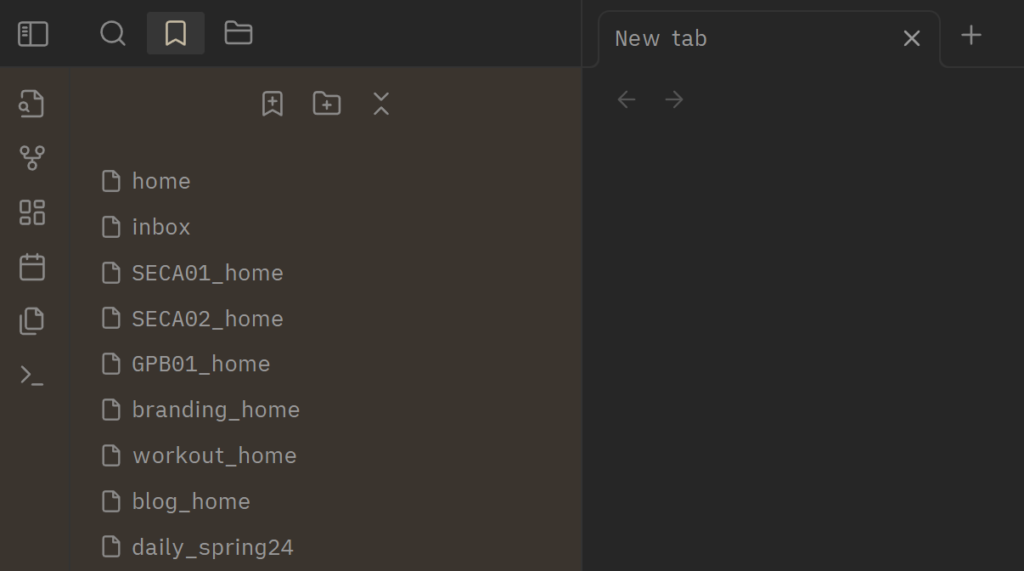
Maps of Content1 are essentially meta-notes that link to related pages, or a table of contents if you will. Tags sort of do the same thing, but MOCs allow you to add some structure and context. I use them as landing pages for projects. MOCs and project homepages can be easy to create with the use of the Dataview plugin explained later.
Adding it as a bookmark gives you yet another in into your vault. Redundancy is really not a bad thing when it comes to PKMs. This type of note is only useful when you have enough notes related to a topic, don’t feel the need to create structure a priori.
List pages
I maintain lists of books I want to read, movies and TV shows I want to watch. They’re easy to access when you’re on the move so if you’re at a bookstore or wondering what to watch when doomscrolling on Netflix, you’ll have some inspiration 🙂
Tips and Tricks
Hotkeys
Here’s a list of useful shortcuts I use all the time. My goal with hotkeys is to minimize the number of times I switch to using the mouse and back, and preferably never move away from the home row.
- ctrl+p – opens the command palette. Great for hard to remember shortcuts and otherwise allows for navigation using only the keyboard
- insert template
- Note composer: Extract current selection
- Note composer: Merge current file with another file
- ctrl+o– find or create note using the quick switcher
- ctrl+enter– visit the link under keyboard cursor
- ctrl+ left click OR middle click– visit the link under the mouse cursor
- Preview linked file using ctrl+hover
- ctrl+t– new tab
- ctrl+tab OR ctrl+shift+tab– cycle through open tabs
- ctrl+f– search current file
- ctrl+shift+f– search in all files
- ctrl+left arrow– toggle left sidebar (this isn’t a default hotkey, it needs to be set in the Hotkeys page of the settings menu)
- ctrl+right arrow– toggle right sidebar (this isn’t a default hotkey, it needs to be set in the Hotkeys page of the settings menu)
Replace ctrl with cmd for MacOS
Links to headings and blocks
When you want to link to specific chunks of a page instead of the page itself, you can link to headers or blocks.
A neat trick to reuse content in your vault is by embedding link text in a page using the ![[link to note]] recipe. Combine this with the above mentioned link to headers/blocks recipes to embed specific chunks of content!
Templates
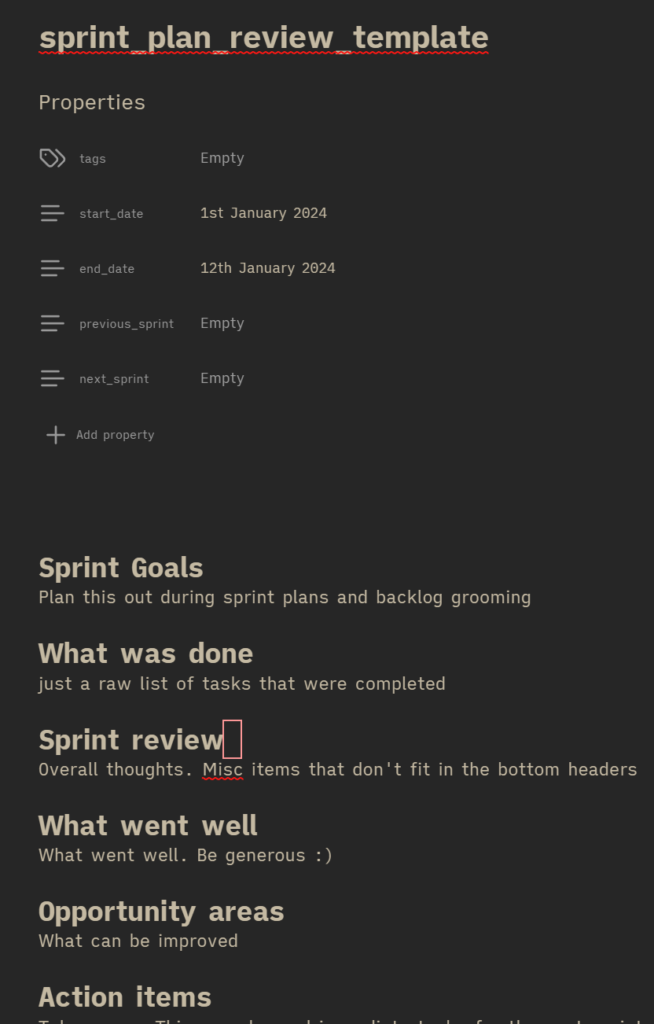
When you find yourself creating the same page structure/meta-data over and over, create a template out of it so you can pre-populate new pages easily. You can add tags, properties, links, headers and pretty much anything else that you’d insert on a normal note.
I run project sprints using the template shown.
Plugins
Obsidian is easy to customize through the use of plugins and themes. Core plugins come built-in with Obsidian, yet a few of them need to be enabled manually. Community plugins are user-developed plugins. There are tons of plugins, from using Chat-GPT as query interface to your notes, to creating kanban boards, and integrating with external apps like Google Calendar or Todoist.
Note composer is useful for merging notes together, or extracting passages from notes into new ones, all while updating and managing valid links.
Dataview is probably the most powerful Obsidian plugin I use and I’ve written an entire section devoted to it.
I also use the Better Word Count and Linter community plugins. Obsidian Importer could be useful to import your notes from other apps. What I haven’t found is a good calendar plugin to keep track of time bound projects (Fantasy Calendar worked for me, but it’s no longer maintained). The Calendar plugin works well if you take daily notes and maintain them as separate files, but that isn’t really my use case.
While it isn’t a plugin, it’s a useful feature nevertheless. The editor allows for vim bindings by checking “Vim key bindings” in the Editor page of the Settings menu. And you can use a custom vimrc using this plugin.
Dataview and MOCs
Dataview is a powerful query engine over your knowledge base. You can use the Dataview Query Language to list, filter, sort or group your pages. Dataview has access to all the metadata of a page such as Properties, tags, links in the page, create date and file name.
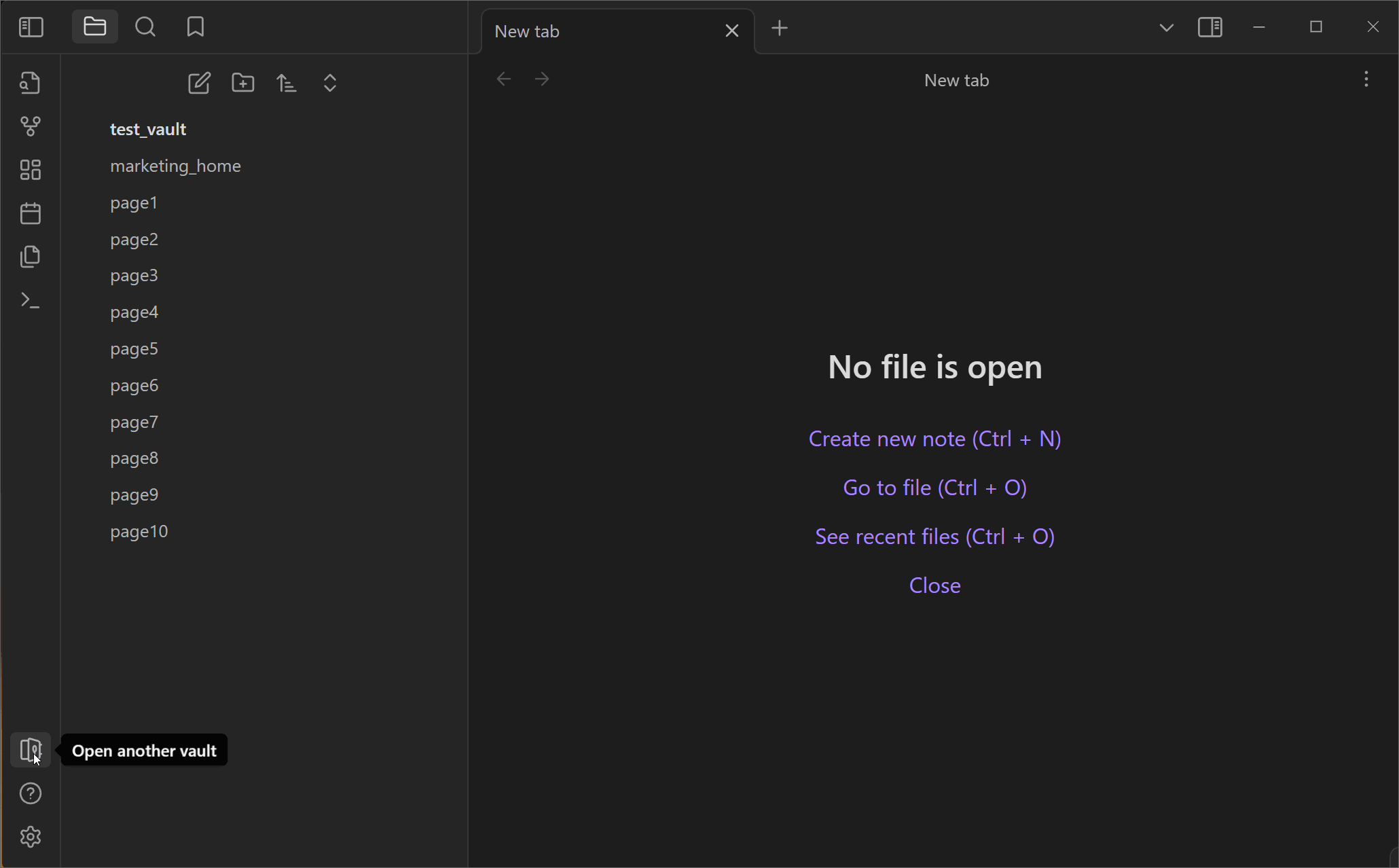
I use it to create Maps of Content to better view and organize pages related to a topic. While you can simply perform a search on a tag, it doesn’t present this information in a coherent way. Create a few home pages for your various project eg. finance_home, fitness_home and now you have good entry points for your notes. Below are a few examples.
Recipe for listing all pages tagged #branding
```dataview
LIST FROM #branding
```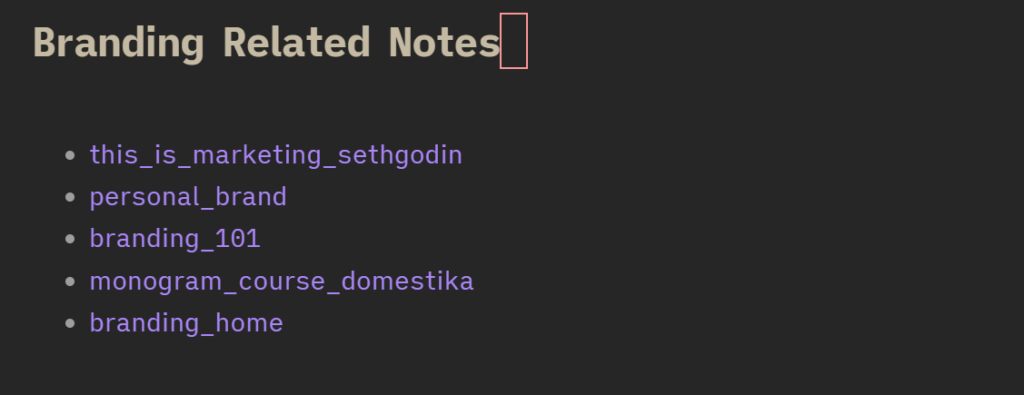
Recipe for creating a table with all pages tagged #SECA02 along with start and end date properties, organized by age
```dataview
TABLE start_date, end_date
FROM #SECA02
SORT file.name ASC```
How to sync Obsidian notes across platforms for free
Disclaimer. The developers of Obsidian have obviously made a compelling app. If you like their work, support them by getting a subscription to Obsidian Sync, the only paid feature of the app. As of the time writing, it costs $8 a month.
Second, this method only works across PCs, Macs and Android. I tried a few different ways to get it to work on iOS devices but they’re so laborious that they aren’t even worth trying. My 2 cents, don’t use iOS 😛
Third, you may find this method to be a little clunky but it’ll do if you’re facing subscription fatigue like I am.
The core of this method involves using Google Drive as a shared home for your Obsidian vaults. (Other cloud storage apps that have syncing functionality should work too). On your PC/Mac, create your vault on Google Drive. All your notes, settings and other metadata used by Obsidian will now be backed up and synced to the cloud. A vault is just a folder btw, it’s just Obsidian’s nomenclature for it.
That should do it if you only need access to your notes on PC/Mac. To access your vault on mobile, you need to create a local folder that is synced to the remote folder/vault on Google Drive. You can use Autosync for this2. Once you’ve configured a two-way sync setup as shown in the images, you’re good to go! Any changes made on your PC will be reflected on your Android device and vice-versa. Syncs can be triggered manually if you need the changes to reflect immediately.
Bear in mind that while the mobile app has all the features that the desktop app has, it’s not as easy to navigate. I use it more to read than to edit. And I tend to stick any spur of the moment thoughts when I’m out in the wild, in the Inbox note which I review and clean later.
Parting thoughts
If you already take notes, you’ll adapt pretty quickly to Obsidian and linking between notes will seem like a game changing addition to your process. If you don’t, build the habit of writing first or PKMs will become just another productivity tool relegated to the trash heap. Obsidian, Notion3, Evernote, whatever. Just get started.
If you’re like me, you’ll spend the first week or so mucking around with all the different options. It’s totally fine to play with your shiny new toy. My suggestion though would be to start using Obsidian regularly to take notes, add organization and complexity over time as you need it. For it to become part of my daily workflow, and for the tool to not get in my way, it took about 2-3 weeks.
When you want to start tracking a new topic or project in Obsidian, your overwhelming impulse might be to add as much structure to it as possible. IMO the right organization for a topic will suggest itself when you’ve accumulated enough notes related to it.
I tried to be as comprehensive as I could and cover the features I use on a regular basis. Let me know in the comments if this was helpful or if there’s anything else you’d like me to cover!
- Or MOCs. This is the technical term for it if you’re trying to look it up on Obsidian forums ↩︎
- Technically, it’s a free app but you’ll need to upgrade via an in-app purchase. It is a lifetime purchase for $10 or so which I think is quite reasonable ↩︎
- A lot of the ideas explained in this post will likely work just as well on Notion. I personally have zero experience with it, but I gather that it has more features, may be better geared for collaboration within large teams, has some bloat and that it can be slow beyond a certain number of notes ↩︎
